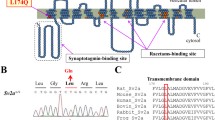Abstract
Aim: Intractable epilepsy is characterized of seizure resistance to the anti-epileptic drugs. The underlying mechanisms are still elusive. Alterations of synaptic vesicle traffic may be one of the candidate mechanisms. Methods: Phenytoin-resistant and phenytoin-non resistant epileptic rats were selected in the amygdala kindled adult male Wistar rats. Synaptotagmin-I and clathrin were determined by cDNA microarry analysis and Western blotting in the hippocampus of phenytoin-resistant and phenytoin-nonresistant kindled rats, which were associated with the exocytosis and endocytosis of the synaptic vesicle traffic. Results: Microarry analysis showed both synaptotagmin-I and clathrin mRNA were up-regulated at least 3.06 fold accompanied with their correspondent proteins increased by 52.3 ± 6.4 % and 76.7 ± 12.4 % respectively in the hippocampus of phenytoin-resistant rats as compared with those in phenytoin-nonresistant rats. There were no significant differences in plasma phenytoin concentrations between the two groups. Conclusions: The increased expressions of synaptotagmin-I and clathrin in the hippocampus of phenytoin-resistant kindled rats play a role in the development of intractable epilepsy.


Similar content being viewed by others
References
Sperling MR (2004) The consequences of uncontrolled epilepsy. CNS Spectr 9:98–99
Hui E, Bai J, Chapman ER (2006) Ca2+ -triggered simultaneous membrane penetration of the tandem C2-domains of Synaptotagmin I. Biophys J 91(5):1767–1777. doi:10.1529/biophysj.105.080325
Yoshihara M, Littleton JT (2002) Synaptotagmin I functions as a calcium sensor to synchronize neurotransmitter release. Neuron 36:897–908. doi:10.1016/S0896-6273(02)01065-6
Fernández-Chacón R, Konigstorfer A, Gerber SH, Garcia J, Matos MF, Stevens CF, Brose N, Rizo J, Rosenmund C, Südhof TC (2001) Synaptotagmin-1 functions as a calcium regulator of release probability. Nature 410:41–49. doi:10.1038/35065004
Nishiki T, Augustine GJ (2004) Synaptotagmin I synchronizes transmitter release in mouse hippocampal neurons. J Neurosci 24(27):6127–6132. doi:10.1523/JNEUROSCI.1563-04.2004
Rappoport JZ, Kemal S, Benmerah A, Simon SM (2006) Dynamics of clathrin and adaptor proteins during endocytosis. Am J Physiol Cell Physiol 291:C1072–C1081. doi:10.1152/ajpcell.00160.2006
Loscher W, Rundfeldt C (1991) Kindling as a model of drug-resistant partial epilepsy: selection of phenytoin-resistant and nonresistant rats. J Pharmacol Exp Ther 258:483–489
Sonna LA, Wenger CB, Flinn S, Sheldon HK, Sawka MN, Lilly CM (2004) Exertional heat injury and gene expression changes: a DNA microarray analysis study. J Appl Physiol 96:1943–1953. doi:10.1152/japplphysiol.00886.2003
Löscher W, Rundfeldt C, Hönack D (1993) Pharmacological characterization of phenytoin-resistant amygdaloid-kindled rats, a new model of drug-resistant partial epilepsy. Epilepsy Res 15:207–219. doi:10.1016/0920-1211(93)90058-F
Racine R, Okujava V, Chipashvili S (1972) Modification of seizure activity by electrical stimulation III Mechanism. Electroencephalogr Clin Neurophysiol 32:295–299. doi:10.1016/0013-4694(72)90178-2
Cramer S, Ebert U, Löscher W (1998) Characterization of phenytoin-resistant kindled rats, a new model of drug-resistant partial epilepsy: comparison of inbred strains. Epilepsia 39:1046–1053. doi:10.1111/j.1528-1157.1998.tb01289.x
Guo X, Yang G (2004) Affection of freezing store on the determination of phenytoin and carbamazepinein human plasma. J Henan Univ 23:22–23 Medical Science
Ebert U, Loscher W (1999) Characterization of phenytoin-resistant kindled rats, a new model of drug-resistant partial epilepsy: influence of genetic factors. Epilepsy Res 33:217–226. doi:10.1016/S0920-1211(98)00087-4
Racine RJ, Steingart M, McIntyre DC (1999) Development of kindling-prone and kindling-resistant rats: selective breeding and electrophysiological studies. Epilepsy Res 35:183–195
Nanobashvili ZI, Chachua TR, Bilanishvili IG, Beradze GG, Gotsadze TR, Khizanishvili NA (2005) Possible mechanism of blocking of limbic motor seizure reactions induced by activation of the thalamic reticular nucleus. Neurophysiology 37:308–316. doi:10.1007/s11062-006-0005-2
Poskanzer KE, Marek KW, Sweeney ST, Davis GW (2003) Synaptotagmin I is necessary for compensatory synaptic vesicle endocytosis in vivo. Nature 426:559–563. doi:10.1038/nature02184
Piehl M, Lehmann C, Gumpert A, Denizot JP, Segretain D, Falk MM (2007) Internalization of large double-membrane intercellular vesicles by a clathrin-dependent endocytic process. Mol Biol Cell 18:337–347. doi:10.1091/mbc.E06-06-0487
Shi G, Faundez V, Roos J, Dell’Angelica EC, Kelly RB (1998) Neuroendocrine synaptic vesicles are formed in vitro by both clathrin-dependent and clathrin-independent pathways. J Cell Biol 143:947–955. doi:10.1083/jcb.143.4.947
Haucke V, Wenk MR, Chapman ER, Farsad K, De Camilli P (2000) Dual interaction of synaptotagmin with the mu2 and alpha subunits of AP-2 facilitates clathrin pit nucleation. EMBO J 19:6011–6019. doi:10.1093/emboj/19.22.6011
Li L, Chin LS, Shupliakov O, Brodin L, Sihra TS, Hvalby O, Jensen V, Zheng D, McNamara JO, Greengard P (1995) Impairment of synaptic vesicle clustering and of synaptic transmission, and increased seizure propensity, in synapsin I-deficient mice. Proc Natl Acad Sci USA 92:9235–9239. doi:10.1073/pnas.92.20.9235
Acknowledgments
This work was supported by the Chinese National Institutes of Health Grants 98013457 to Dr. Xuefeng Wang and Natural Science Fund of Chongqing 08046 to Dr. Kebin Zeng.
Author information
Authors and Affiliations
Corresponding author
Rights and permissions
About this article
Cite this article
Zeng, K., Wang, X., Wang, Y. et al. Enhanced Synaptic Vesicle Traffic in Hippocampus of Phenytoin-Resistant Kindled Rats. Neurochem Res 34, 899–904 (2009). https://doi.org/10.1007/s11064-008-9856-9
Received:
Accepted:
Published:
Issue Date:
DOI: https://doi.org/10.1007/s11064-008-9856-9




